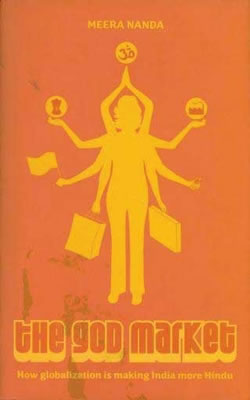 The God Market: How Globalisation is Making India More Hindu by Meera Nanda (Random House India)
The God Market: How Globalisation is Making India More Hindu by Meera Nanda (Random House India)
Two stories have dominated the headlines out of India over the last decade. One is India’s march towards the status of an economic superpower. The other is the emergence of a hard-line Hindu nationalism that at its most extreme seeks to substitute a secular India with a Hindustan where religious minorities hold second place.
A new book, The God Market by John Templeton research fellow Meera Nanda, seeks to link these two phenomena. Nanda argues that “as India’s economy has liberated, so too has it become more Hinduised”. Her thesis is that India’s growing wealth has created a nexus between the state, temple and business that has fuelled the rise of a new Hindu fundamentalism that threatens secularism itself. She cites the rise of powerful new “god-men”, an increase in temple rituals among the middle class, politicians using Hindu prayers and pilgrimages as part of political campaigning.
Taking in a survey of India’s economic growth, the rise of religiosity among the country’s burgeoning middle class, and an analysis of the way in which a sense of Hindu exceptionalism informs the country’s image of itself in the world, she concludes that globalisation and Hinduisation have become fatally intertwined: “neoliberal economic policies have worked to the advantage of the God market.”
Nanda is particularly concerned by the way in which Hindu nationalists have claimed India’s economic success as their own, and the threat this poses to India’s unique and hard-fought secular system. Among her suggested solutions are the creation of “more meaningful secular spaces” in public life and the urgent need to tackle the inequality that fuels religious radicalism.
On this Nanda is passionate and convincing, and I agree. But I disagree with the book’s central thesis that posits a fixed causal link between globalisation and the rise of Hindu nationalism. The book lacks a convincing argument to support this thesis and also lacks the first-hand testimony that could have given the argument much-needed ballast and colour.
There is no doubt that India has witnessed a rise in Hindu nationalism over the past decade, culminating in the BJP rise to power in the late ’90s on a wave of Hindu pride and a call for a new type of politics called “Hindutva” whose underlying ambition was the creation of a Hindu Raj.
The BJP ideology also included preaching market liberalisation. Its government continued the previous Congress government policy of opening up India’s economy while at the same time professing pride in protecting national interests.
So, yes, there is a link between globalisation and Hindu nationalism.
But globalisation did not cause India to become “Hinduised”. It was politics and history that did that.
The Hindu nationalist movement, which is at the root of the resurgent Hindu pride seen in today’s India, was conceived in the 1920s. The BJP is the political arm of a wider movement that stems from the parent body, the Rastriya Swayamsevak Sangh (RSS) or Association of National Volunteers, formed in 1925. For India’s first Congress prime minister, Jawaharlal Nehru, the RSS represented an “Indian form of fascism”.
So Hindutva’s origins were in the century before globalisation. The BJP rose to power in the 1990s by stoking religious conflicts, around which they could rally Hindu sentiment. The most famous example was the campaign for the destruction of a 400-year-old mosque in Ayodhya. They claimed the mosque was built on the site of a Hindu temple dedicated to Lord Ram. In 1992 Hindu nationalist supporters tore the mosque to the ground, igniting communal warfare between Hindus and Muslims.
The RSS and its affiliates have spent years pumping money into these campaigns as well as Hindu charities, schools and other public ventures to bind together the Hindu vote.
All this helped propel the BJP to the national stage and in 1998 they were swept to power, backed by a large middle-class vote as well as poor and angry Hindu youth who felt they now had a religious and political cause.
As globalisation leads to sweeping change around the world, India is not immune to the import of modern and westernised values. In that sense globalisation is linked to a retreat into orthodoxy for some Hindus.
But in the last two general elections the BJP has lost to the secular Congress Party. Many political commentators have interpreted this as a rejection of the Hindutva ideology by the electorate. The BJP’s defeat is good news for India’s secularists. The decline in the political fortunes of the BJP, its more extreme ally Shiv Sena and Hindutva generally has coincided neatly with the rise of India’s economy in the globalised world.
As Indians become richer they may be choosing to spend more money on pilgrimages, or donations to the temple or mosque or gurdwara – as Nanda argues. But the lure of religious-based politics seems to have abated – for now.
There are great risks to Indian secularism, especially if the fruits of economic resurgence are not distributed equally. But the relationship between globalisation and religious extremism is more complex, and more ambivalent, than Nanda’s simplistic argument allows.

